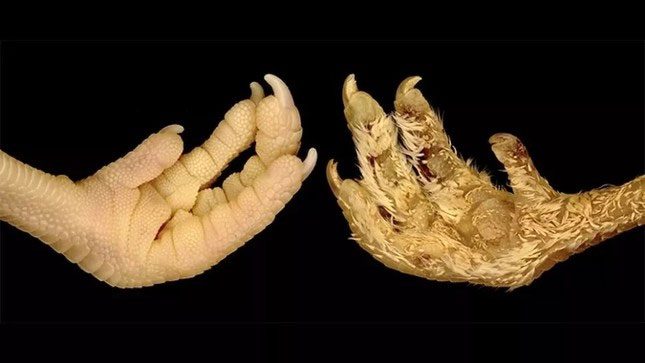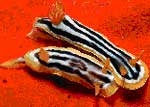By targeting a single gene, scientists have successfully transformed chicken scales into feathers.
By adjusting a specific gene, researchers discovered a method to permanently alter the scales on chicken legs into feathers. These results provide new insights into the evolutionary origins of birds from dinosaurs.

Two chicken legs, one with feathers and one with scales.
Michel Milinkovitch, a professor in the Department of Genetics and Evolution at the University of Geneva, Switzerland, and co-author of the new study, stated: “Similar to birds, it is clear that many dinosaur species were partially covered in feathers as well as scales. This is also true for birds. Therefore, by altering the gene, we can actually expand or reduce the body area covered by feathers or scales depending on when this gene is expressed.”
To carry out this gene transformation, Swiss scientists targeted the Sonic Hedgehog (Shh) gene, which controls a signaling pathway that determines the development of certain traits at the embryonic level, including the brain and spinal cord, limbs, and skin appendages like scales and feathers, according to research published on May 17 in the journal Science Advances.
Egg Candling
In the laboratory, the researchers used a process called “egg candling,” which involves using a light source to illuminate the blood vessels inside the egg. This allowed them to identify an appropriate area to directly inject a molecule that activates Shh into the developing embryo. For the study, they used broiler chickens (Gallus gallus localus), which are bred for commercial meat production.
Lead author Rory Cooper, a postdoctoral researcher in artificial and natural evolution at the University of Geneva, explained: “We performed the injection on day 11, which is precisely when scales typically arise on the embryo. If we had injected even a day later, the embryo would have already begun to develop scales.”
After the eggs hatched, the scientists observed the formation of down feathers on the chicken legs. According to their statement, these ultra-soft feathers are comparable to those covering the rest of their bodies.
Cooper noted: “The effect is really clear when they hatch. And the change is permanent. Once the chickens grow feathers, they will not revert to having scales in the targeted area.”
The researchers were surprised by how easily they could alter the shape of chicken legs, stating that it provided the team with new insights into how these animals evolved.
“Feathers have functional changes,” Milinkovitch said. “In dinosaurs, feathers could be used to regulate the internal temperature of the animal or as a colorful display. The process of flight occurred thereafter. By changing the expression of a gene, we can create a range of developmental effects that activate feather development, offering new insights into the evolution of these animals.”





















































